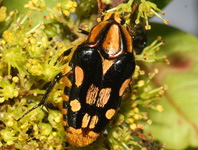Abstract
The Brazilian tapaculo Scytalopus speluncae species-group has been the subject of intense taxonomic work in the past 18 years, with six new species being named in that time lapse and other taxonomic problems having been highlighted (Bornschein et al. 1998, 2007; Maurício 2005; Raposo et al. 2006, 2012; Mata et al. 2009; Whitney et al. 2010; Maurício et al. 2010, 2014; Pulido-Santacruz et al. 2016). One of the most persistent of these problems involves the oldest name in this group, S. speluncae (Ménétriès), and the taxa it may represent. Historically, this name has been applied to the dark gray populations (whose adult males have plain gray flanks) occurring along coastal mountains between Espírito Santo and São Paulo states in Brazil (Raposo et al. 2006; Maurício et al. 2010). Subsequently, dark gray populations from the Brazilian states of Paraná, Santa Catarina, and Rio Grande do Sul, as well as paler gray birds with black-barred brown flanks from northeastern Argentina (Misiones Province) and adjacent southern Brazilian states were also subsumed under S. speluncae (Bornschein et al. 1998; Maurício 2005; Maurício et al. 2010). However, the paler gray, barred populations from Argentina and some parts of Santa Catarina and Rio Grande do Sul have proved to be a distinct and partially sympatric species named S. pachecoi Maurício, which was shown to be not closely related to S. speluncae, but rather pertains to the very divergent clade of S. novacapitalis Sick and related forms (Maurício 2005; Mata et al. 2009). On the other hand, the dark-gray populations coming from Espírito Santo south to Rio Grande do Sul continued to be identified as S. speluncae.
References
Azevedo, M.A.G. & Ghizoni-Jr., I.R. (2008) Aves. In: Cherem, J.J. & Kammers, M. (Eds.), A Fauna das Áreas de Influência da Usina Hidrelétrica de Quebra Queixo. Habilis, Erechim, pp. 131–149.
Bornschein, M.R., Maurício, G.N., Belmonte-Lopes, R., Mata, H. & Bonatto, S.L. (2007) Diamantina Tapaculo, a new Scytalopus endemic to the Chapada Diamantina, northeastern Brazil (Passeriformes: Rhinocryptidae). Revista Brasileira de Ornitologia, 15, 151–174.
Bornschein, M.R., Reinert, B.L. & Pichorim, M. (1998) Descrição, ecologia e conservação de um novo Scytalopus (Rhinocryptidae) do sul do Brasil, com comentários sobre a morfologia da família. Ararajuba, 6, 3–36.
Dickinson, E.C. & Christidis, L. (Eds.) (2014) The Howard and Moore Complete Checklist of the Birds of the World. Vol. 2. Passerines. Aves Press, Eastbourne, U.K., 752 pp.
Fjeldså, J. (2013) The discovery of new bird species. In: del Hoyo, J., Elliot, A., Sargatal, J. & Christie, D.A. (Eds.), Handbook of the Birds of the World. Special Volume: New Species and Global Index. Lynx Edicions, Barcelona, pp. 147–185.
Krabbe, N. & Schulenberg, T.S. (1997) Species limits and natural history of Scytalopus tapaculos (Rhinocryptidae), with descriptions of the Ecuadorian taxa, including three new species. Ornithological Monographs, 48, 47–88.
https://doi.org/10.2307/40157527
Krabbe, N. & Schulenberg, T.S. (2003) Family Rhinocryptidae (Tapaculos). In: del Hoyo, J., Elliot, A., & Christie, D.A. (Eds.), Handbook of the Birds of the World. Volume 8: Broadbills to Tapaculos. Lynx Edicions, Barcelona, pp. 748–787.
Mata, H., Fontana, C.S., Maurício, G.N., Bornschein, M.R., Vasconcelos, M.F. & Bonatto, S.L. (2009) Molecular phylogeny and biogeography of the eastern tapaculos (Aves: Rhinocryptidae: Scytalopus, Eleoscytalopus): Cryptic diversification in Brazilian Atlantic Forest. Molecular Phylogenetics and Evolution, 53, 450–462.
https://doi.org/10.1016/j.ympev.2009.07.017
Maurício, G.N. (2005) Taxonomy of southern populations in the Scytalopus speluncae group, with description of a new species and remarks on the systematics and biogeography of the complex (Passeriformes: Rhinocryptidae). Ararajuba, 13, 7–28.
Maurício, G.N., Belmonte-Lopes, R., Pacheco, J.F., Silveira, L.F., Whitney, B.M., & Bornschein, M.R. (2014) Taxonomy of “Mouse-colored Tapaculos” (II): An endangered new species from the montane Atlantic Forest of southern Bahia, Brazil (Passeriformes: Rhinocryptidae: Scytalopus). Auk, 131, 643–659.
https://doi.org/10.1642/AUK-14-16.1
Maurício, G.N., Bornschein, M.R., Vasconcelos, M.F., Whitney, B.M., Pacheco, J.F. & Silveira, L.F. (2010) Taxonomy of “Mouse-colored Tapaculos”. I. On the application of the name Malacorhynchus speluncae Ménétriés, 1835 (Aves: Passeriformes: Rhinocryptidae). Zootaxa, 2518, 32–48.
Nemésio, A., Rasmussen, C., Aguiar, A.P., Pombal, Jr., J.P. & Dubois. A. (2013) Nomenclatural issues in ornithology: the incredible controversy on the identity of a long overlooked Brazilian bird. Zootaxa, 3734 (2), 241–258.
https://doi.org/10.11646/zootaxa.3734.2.8
Piacentini, V.Q., Aleixo, A., Agne, C.E., Maurício, G.N., Pacheco, J.F., Bravo, G.A., Brito, G.R.R., Naka, L.N., Olmos, F., Posso, S., Silveira, L.F., Betini, G.S., Carrano, E., Franz, I., Lees, A.C., Lima, L.M., Pioli, D., Schunck, F., Amaral, F.R., Bencke, G.A., Cohn-Haft, M., Figueiredo, L.F.A., Straube, F.C. & Cesari, E. (2015) Annotated checklist of the birds of Brazil by the Brazilian Ornithological Records Committee. Revista Brasileira de Ornitologia, 23, 91–298.
Pulido-Santacruz, P., Bornschein, M.R., Belmonte-Lopes, R. & Bonatto, S.L. (2016) Multiple evolutionary units and demographic stability during the last glacial maximum in the Scytalopus speluncae complex (Aves: Rhinocryptidae). Molecular Phylogenetics and Evolution, 102, 86–96.
https://doi.org/10.1016/j.ympev.2016.05.027
Raposo, M.A., Kirwan, G.M., Loskot, V. & de Assis, C.P. (2012) São João del Rei is the type locality of Scytalopus speluncae (Aves: Passeriformes: Rhinocryptidae)—a response to Maurício et al. (2010). Zootaxa, 3439, 51–67.
Raposo, M.A., Stopiglia, R., Loskot, V. & Kirwan, G.M. (2006) The correct use of the name Scytalopus speluncae (Ménétriés, 1835), and the description of a new species of Brazilian tapaculo (Aves: Passeriformes: Rhinocryptidae). Zootaxa, 1271, 37–56.
Remsen, Jr., J.V., Areta, J.I., Cadena, C.D., Jaramillo, A., Nores, M., Pacheco, J.F., Pérez-Emán, J., Robbins, M.R., Stiles, F.G., Stotz, D.F. & Zimmer, K.J. (2016) A Classification of the Bird Species of South America, version 20, May 2016. Available from: http://www.museum.lsu.edu/~Remsen/SACCBaseline.html (accessed 20 May 2016)
Smithe, F.B. (1975) Naturalist’s Color Guide. American Museum of Natural History, New York.
Straube, F.C., Urben-Filho, A. & Cândido-Jr, J.F. (2004) Novas informações sobre a avifauna do Parque Nacional do Iguaçu (Paraná). Atualidades Ornitológicas, 120, 10.
Whitney, B.M., Vasconcelos, M.F., Silveira, L.F. & Pacheco, J.F. (2010) Scytalopus petrophilus (Rock Tapaculo): a new species from Minas Gerais, Brazil. Revista Brasileira de Ornitologia, 18, 73–88.

